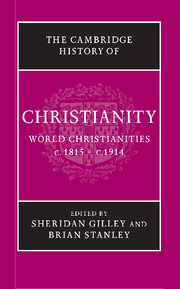Book contents
- Frontmatter
- 1 Introduction
- PART I CHRISTIANITY AND MODERNITY
- PART II THE CHURCHES AND NATIONAL IDENTITIES
- PART III THE EXPANSION OF CHRISTIANITY
- 26 African-American Christianity
- 27 Christian missions, antislavery and the claims of humanity, c.1813–1873
- 28 The Middle East: western missions and the Eastern churches, Islam and Judaism
- 29 Christians and religious traditions in the Indian empire
- 30 Christianity in East Asia: China, Korea and Japan
- 31 Christianity in Indochina
- 32 Christianity as church and story and the birth of the Filipino nation in the nineteenth century
- 33 Christianity in Australasia and the Pacific
- 34 Missions and empire, c.1873–1914
- 35 Ethiopianism and the roots of modern African Christianity
- 36 The outlook for Christianity in 1914
- Select General Bibliography
- Chapter Bibliography
- Index
- References
34 - Missions and empire, c.1873–1914
from PART III - THE EXPANSION OF CHRISTIANITY
Published online by Cambridge University Press: 28 March 2008
- Frontmatter
- 1 Introduction
- PART I CHRISTIANITY AND MODERNITY
- PART II THE CHURCHES AND NATIONAL IDENTITIES
- PART III THE EXPANSION OF CHRISTIANITY
- 26 African-American Christianity
- 27 Christian missions, antislavery and the claims of humanity, c.1813–1873
- 28 The Middle East: western missions and the Eastern churches, Islam and Judaism
- 29 Christians and religious traditions in the Indian empire
- 30 Christianity in East Asia: China, Korea and Japan
- 31 Christianity in Indochina
- 32 Christianity as church and story and the birth of the Filipino nation in the nineteenth century
- 33 Christianity in Australasia and the Pacific
- 34 Missions and empire, c.1873–1914
- 35 Ethiopianism and the roots of modern African Christianity
- 36 The outlook for Christianity in 1914
- Select General Bibliography
- Chapter Bibliography
- Index
- References
Summary
New directions in missionary strategy
‘Christianity, commerce and civilisation’: it was shown in chapter 27 above that no phrase encapsulated more pithily the fundamental dynamism which mid-nineteenth-century Christians believed underpinned the expansion of their faith overseas. Nowhere was there a more pointed indication of the indeterminate relationship that existed between empires and the global spread of missionary enterprise, two of the most important agencies both for transmitting and for shaping the Christian message. The connections between ‘the three C’s’ highlighted for contemporaries both the essential framework of an expanding system of evangelisation and the ecclesiastical consequences of Christians’ commitment to their obligation to spread the Word. The preaching of Christianity in tandem with the encouragement of a humane and liberal commerce was held to foster a genuinely Christian civilisation. Modelled on the developing capitalist economies of the western world, that civilisation, as it too prospered, would also develop its own churches. These were expected to become self-financing, then self-governing, and, after the emergence of sufficient local clergy and evangelists, self-propagating. At that point the missions’ specific local task was complete, and missionaries could be released to work in fresh, hitherto unevangelised fields.
Although the most influential contributions to the exposition and popularisation of this missionary strategy were those of Henry Venn of the CMS and David Livingstone of the LMS, this, as was emphasised in chapter 27, was far from being a purely British perspective on missions. It was at once widespread and long-lasting: Roman Catholic as well as North American Protestant missions spurred on by Rufus Anderson at the American Board of Commissioners for Foreign Missions in Boston also developed their thinking along similar lines.
- Type
- Chapter
- Information
- The Cambridge History of Christianity , pp. 560 - 575Publisher: Cambridge University PressPrint publication year: 2005
References
- 1
- Cited by

